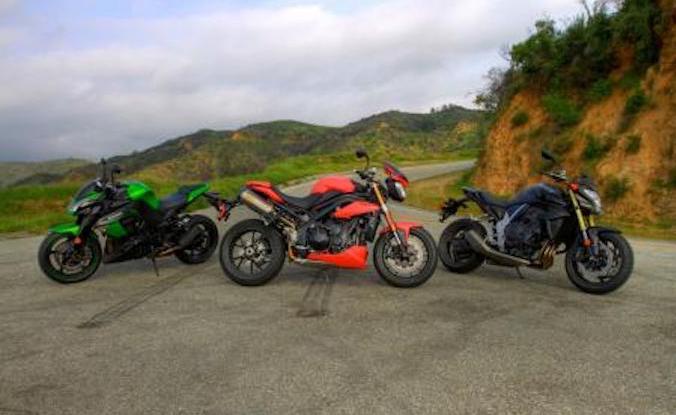Church Of MO: 2011 Literbike Streetfighter Shootout
Tomorrow, we embark on a great crusade: the 2021 Lightweight Nakedbike comparison. So it’s probably an excellent time to look back 10 years ago, to when Pete, Trizzle, and Duke compared, lamented, proffered, proclaimed and opined re: the three most powerful naked streetfighters of the day. Let us harken…
Honda CB1000R vs. Kawasaki Z1000 vs. Triumph Speed Triple
[There’s a cool, wheelie-filled video I couldn’t paste in here, but you can see it if you click here.]
Powered by a superbike inline-Four, the wasp-waisted, futuristic-looking CB has the goods to potentially cause lots of trouble for both the Speed and the Z. Triumph’s revised-for-2011 Speed Triple is ready to reassert itself against the returning Kawasaki Z1000 – a bike we deemed last year as our preferred hooligan mount. But the brutish Z won’t have it so easy this year since the new-to-America Honda CB1000R is entered in the naked-bike fray.
Three-way slugfest of power!
With displacements from 998cc to 1050cc, there’s no shortage of power ’tween this trio. However, an outright dyno champ did emerge.
For 2011 Triumph reworked the potent 1050cc inline-Triple in the venerable Speed, with an emphasis on boosting upper-rpm power. As Troy Siahaan pointed out in his review of the updated Speed, Triumph chose to sacrifice some low-end – and a little bit of the mid-range – power in the new engine. Triumph claims the Triple isn’t quite as strong below roughly 4800 rpm as the 1050 from last year. But we didn’t notice any deficit, and neither did the dyno.
The 2011 S3 managed 121.3 hp at 9200 rpm and 74.7 ft-lbs at 7800 rpm, edging out the Kawasaki’s 119.0 hp at 10,100 rpm and 71.6 ft-lbs at 7800 rpm. Our Z came up four ponies short of our 2010 model’s 123.1 hp.
But in the interest of objectivity, we must offer full disclosure that our Triumph test unit came equipped with dual slip-on Arrow exhaust cans, as that was the only bike Triumph had available when we pieced this battle together.
While a couple peak horsepower and ft-lbs advantage for the Tri isn’t worlds better than what the Z’s strong inline-Four produced, the Triple looks to have picked up considerable top-end poke compared to the 115 hp it made for us last year.
The Triumph always had a deep well of low-end power, but judging by the gap it put on the Z, the Speed’s low-rpm power is as at least as strong as last year despite Triumph’s claim of moderately reduced low-end performance.
From the minute the dyno started recording twisting force, the S3 simply ran away from the Zee. Although the Triple ceded some ground to the Kawi near peak power and torque, it ultimately was a wire-to-wire win for the Triumph in the dyno room.
The CB1000R is the one bike in this collection that can lay claim to running with a genuine modern superbike-based engine. Troy’s recent ride report on the freshly imported CB-R reveals that Honda sourced the CB’s engine directly from the 2006/07 CBR1000RR.
In our first look last year at the then-not-U.S.-bound CB1000R, our Canadian motorjournalist buddy Costa Mouzouris informed us the ’06-’07 CBR1000RR mill had a longer stroke than the current model RR, and thusly was better suited for street duty in the CB thanks to better mid-range power potential. Other tweaks given the repurposed literbike powerplant are smaller throttle bodies and reduced compression ratio said to further expand its streetability.
The CB proves to be strong right off idle. The dyno shows the Honda softens between approximately 3500 to 4800 rpm, but once past this dip the CB spools up and delivers smooth, tractable power. For a short span the CB1KR even manages to pace the Z1K, but after 6000 rpm or so, it’s all over but the cryin’ for the CB. When it comes to hard numbers, Honda may have tuned out too much of the CBR-RR’s raciness.
Final dyno numbers for the Honda were 107.1 hp at 10,100 rpm and 63.6 ft-lbs at 7200 rpm. By no means do any of us here think this kind of power is insufficient for street riding, but this is, after all, a competition of sorts, and a shortfall of 12 to 14 hp is notable.
Perhaps more disappointing than how the CB’s engine faired against the Kawi and Triumph on the dyno is all the potential Honda had to work with in the RR-based engine. In our 2007 Literbike Shootout the CBR1000RR churned out 147.3 hp at 11,250 rpm and 76.1 ft-lbs at 8500 rpm.
Indeed, the Honda trails the other two in terms of having a thrilling engine, but as you’ll learn, the CB-R offers an overall package that makes for a fun, competent machine with wide-ranging appeal that should interest a variety of riders.
The rest of what makes up these scoots brings them closer together. Suspension works well on all three, and each has a stout frame package, with the Triumph and Honda sporting sexy single-sided swingarms. Stopping prowess is another area wherein nothing is bad and is simply a matter of degrees of goodness. Ergos are likewise well sorted, offering layouts that can suit nearly everyone.
To get to know each bike better, and get a healthy dose of impressions and opinions, we’ll examine this trio more closely. For all the spec sheet jockeys out there looking for the nitty gritty on each bike, make sure to see the comparative specifications table in the article.
More by John Burns

































Comments
Join the conversation
That Speed Triple was just the thing for roaming England's green and pleasant Land.
My choice. Better looking, 130RWHP, 485lbs wet, $10,500
https://external-content.du...